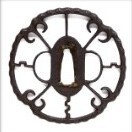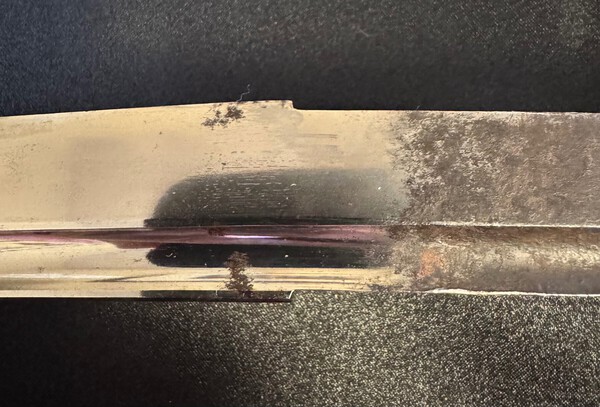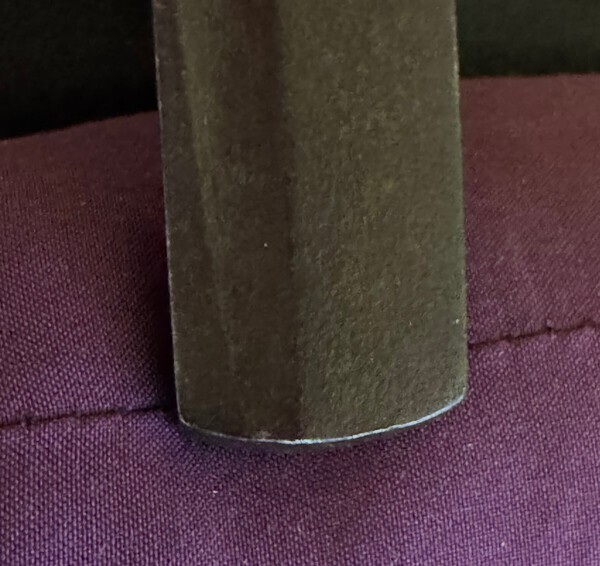-
Posts
202 -
Joined
-
Last visited
-
Days Won
1
Content Type
Profiles
Forums
Events
Store
Downloads
Gallery
Everything posted by Caracal
-
Here are more pictures of the sword, if it can be helpful in describing what kind of sword it might be
-
I have received another answer to my questions about the sword. Interesting what you think. Could it be as follow? "I think this Wakizasi was cut short which means suriage Machiokuri. The texture looks very nice so the blade was made in the early Muromachi period or more. The hamon is hard to see#
-
Hi Alex - My thoughts? The sword is Mumei. I just want to get confirmation from others who have more knowledge on what I see on the sword. Hamon - Togari midare which is hard to see in the picture? Bo hi /muromachi? Suriage (are there none of the original nakago present, Nakago jiri/Kuri Jiri/Haagari? Or Is it a sword that is suriage from Bizen den? Or what can you see? Thanks Rob,
-
-
Hii, What can you see on this sword, a Wakizashi/Suriage? Is it a Muromachi late Koto Mino, unfortunately it is not newly polished so you cannot see the structure of the sword. Thoughts on this sword? Is it the result of blade shortening Suriage (for remounting)? What can you read on Nakago? Unfortunately, there are no better pictures, but thanks in advance to everyone who tries to give an answer. //Rob,
-
Steve! Thanks for the quick response, it was appreciated. //Robert
-
Help with translation please. I would like some help with the translation of this NBTHK Hozon certificate. My question is does it say which school this Tsuba is from and does it just say open work or does it say sukashi tsuba or kyo-sukashi tsuba or what is written on the paper. Thank you in advance for your help //Robert
-
If that's what you're saying, Shirasaya originated in the mid-Edo period when the Honami family of appraisers were employed to evaluate, authenticate, and index the sword collections of important families. So what was done in the past to protect and preserve the sword? How were swords preserved from the Kamakura period onwards?
-
look at this page https://new.uniquejapan.com/an-example-of-a-custom-koshirae-with-edo-period-piece-mountings/
-
Silk-Goods Lane, Odenma-cho Utagawa Hiroshige Japanese, 1797–1858. Silk-Goods Lane, Odenma-cho, No. 74 from One Hundred Famous Views of Edo, 7th month of 1858. The procession is moving along one of the streets in Odenmacho, a wealthy central quarter of the capital, adjoining the Nihonbashi. This quarter, which appeared as the focus of the transport system linking Edo with the rest of the country, became with time one of the busiest shopping areas in the city. Silk fabrics were the main goods sold here and shops selling them could make up whole streets. The print shows the quarter's Third Street, where the largest firms had their trading premises. The most prominent such business was Daimura and the decoration of the awnings and the advertising sign in front of the entrance here feature its trade mark - a circle (maru) containing the character meaning 'big' (dai). The sign proclaims 'All sorts of fabric' and, higher up, either side of the trade mark 'Payment in cash. Prices are not negotiable.' This way of trading was introduced by another cloth dealer in the late seventeenth century...
-
Thanks Uwe, Yes, it doesn't seem easy to find this Mon/Crest. After reading The case of the upside down mon”,Katchû n°4, Jan 2021, it all became a bit more difficult.
-
This mon (crest) is found on a fukigaeshi, and I wonder if anyone knows it and what clan it might belong to.
-
Bungo Yukihira Teikei (定慶)1200’s to 1220’s, early Kamakura period Property of Futarasan Shrine Yukihira
-
Thanks for sharing with us Gary. //Robert
-

Need help translating this text (Hakogai) on a Kiri Box
Caracal replied to Caracal's topic in Translation Assistance
Thank you very much. I appreciate your translation Thanks //Robert -
Thanks! Robert
-
-
Interesting, comments about this kozuka Ko-Kinkou-style, Kurikara Ryu Zu The surface of this Kozuka is decorated with the Nanako-Ji (魚子地) technique. It is made by hitting the Nanako-Ji Tagane (魚子地鏨, chisel used for this technique). Although the surface is worn down due to aging, you could see delicate fish egg-shaped protrusions. About the design, you see a dragon that coils its body around the blade. This motif is called the Kurikara-Ken (倶利伽羅剣), which is the sword that Fudo Myo-O (不動明王, acalanātha) holds with his right hand. Fudo Myo-O is one of the objects of worship in Buddhism. According to a theory, it is the incarnation of Dainichi Nyorai (大日如来, Mahāvairocana, the principal image of esoteric Buddhism). The Kurikara-Ken was named after its appearance that Kurikara Ryu-O (倶利伽羅龍王, dragon) is winding around the sword. It is believed that the Kurikara-Ken could cut off worldly desires: Sandoku (三毒). Sandoku is the three fundamental human desires; Ton (貪, greed), Jin (瞋, anger, grudge), Chi (癡, delusion, complaint). The handle part of this blade looks like the Sankosho (三鈷杵, a type of item of esoteric Buddhism). This Kozuka is recognized by The Society for the Preservation of Japanese Art Swords, which is known as NBTHK.
-
Hello, Thanks for your comments, its no Mei and judged as you say. Thanks //Robert
-
Hello members I would like a statement/assessment of this kozuka with nanako and dragon that I found at a dealer. Is it common, mediocre or? It is a dragon that eats a Varja. The ritsual thunderbolt, vajra in Sanskrit and kongo in Japanese, is a symbol of wisdom. The name vajra means both thunderbolt and diamond, as it is a symbol of brute strength and indestructibility. //Bob
-
Momonari Kabuto, it seems freshly painted (restored?) I wonder what shape it might be as someone paid almost 4000 euros for it. Interesting if anyone has knowledge of this type of helmet. I've never seen one like that before, but you never know.
-
Here is the description: Kabuto helmet with yoroi mask, Edo (1603-1868). Kabuto with a moon-shaped datemono. Menpo men yoroi with mustache. Black lacquered. Shikoro with four slats laced with sugake-odoshi. Yoroi mask with red lacquered inside.
-
-
Dōjigiri (童子切, "Slayer of Shuten-dōji") Tokyo National Museum























